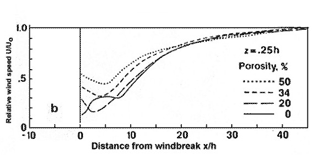|
Porosity of the Shelterbelt
True or aerodynamic porosity is the degree to
which wind can pass through a windbreak, but is difficult
to measure in a three dimensional shelterbelt. Optical porosity
is generally used as an approximation for true porosity and
is estimated from the percentage of background visible through
a windbreak.
Shelterbelts with a high porosity allow more air to move through
the belt rather than around or over it, hence there is less
reduction in wind speed downwind. In this case, the area of
maximum reduction is further from the belt compared to a belt
of low porosity. The total area sheltered is similar for belts
of both high and low porosity. A sloping cross-sectional profile
is thought to increase the true porosity by lifting wind up
and over the windbreak.

Reference: Heisler, G.M. and Dewalle,
D. (1988), 'Effects of Windbreak Structure on Wind Flow',
Agriculture Ecosystems and Environment Vol. 22/23, pp 41-69.
.gif)
Reference: Cleugh, H. (1997), 'Trees for
Shade and Shelter' in Design Principles for Farm Forestry:
A guide to assist farmers to decide where to plant trees and
farm plantations on farms eds. Abel, N. et al, RIRDC, Canberra,
pp.39-52
Back to top
|
